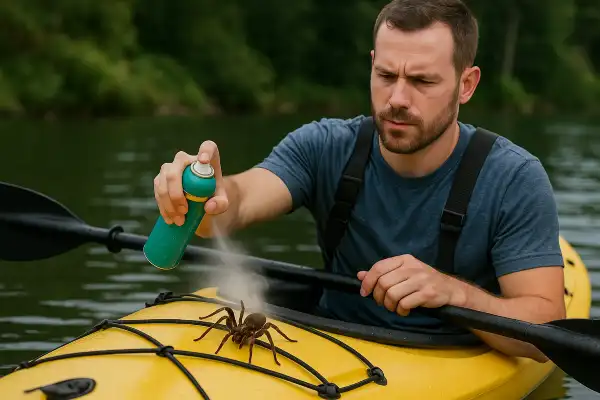Nothing ruins a peaceful morning paddle quite like discovering an eight-legged passenger has taken up residence in your cockpit. How to get rid of spider in a kayak becomes a pressing concern when you’re faced with webs stretched across your seating area or catch a glimpse of movement in the corner of your boat.
Last summer, I returned to my trusty sea kayak after a week-long kayak camping trip in Texas only to find it had become prime real estate for several species of local arachnids. The combination of shelter, occasional moisture, and nearby insect activity had made my beloved vessel into spider central. That experience taught me the importance of both immediate removal techniques and long-term prevention strategies that every paddler should master in kayak camping.
How to get rid of spider in a kayak?
The most effective immediate method to remove spiders from your kayak is filling the boat with water mixed with a small amount of dish soap, allowing it to sit for 30-60 minutes, then thoroughly rinsing it clean. This approach kills spiders and other insects while forcing any hiding creatures to evacuate.
However, this water-filling method isn’t always practical, especially if you’re at a launch site or need to use your kayak in a kayak camping solo immediately. Understanding multiple removal approaches gives you options based on your specific situation and the level of spider presence you’re dealing with.

Immediate removal techniques
The flood-and-flush method represents the most thorough approach for heavily infested kayaks. Add a small amount of dish soap to water, fill the kayak, let it soak for an hour, then rinse thoroughly. The soap breaks surface tension and ensures any spiders cannot simply float to safety. This method works particularly well for sit-inside kayaks where spiders often establish webs in hard-to-reach areas.
Vacuum removal provides immediate results when you need to use your kayak quickly. Spider physiology cannot withstand the suction of most vacuum cleaners, and the force kills them almost instantly. Use a shop vacuum or regular household vacuum with hose attachment to reach cockpit corners, behind seat backs, and storage compartments. Remember to empty the vacuum bag or canister immediately after use.
High-pressure water rinse offers a chemical-free solution that works especially well for sit-on-top kayaks. Direct a strong stream of water into all corners, crevices, and gear tracks. The force dislodges spiders and destroys webs simultaneously. Pay special attention to areas around bungee deck rigging and rod holders where spiders frequently anchor their webs.
Natural repellent solutions
Peppermint oil spray has gained popularity among paddlers as a natural deterrent. Research shows peppermint oil repels certain spider species, with spiders avoiding areas treated with the oil in more than 75% of tests. Mix 10-15 drops of pure peppermint essential oil with 16 ounces of water and a small amount of dish soap. Spray this mixture around cockpit rims, seat areas, and storage compartments weekly during spider season.
Scientific testing confirms that chestnuts and mint oil strongly repelled certain spider species, while lemon oil had no effect. This research validates the traditional wisdom behind peppermint oil while debunking some internet myths about citrus-based repellents.
Vinegar solutions provide another natural option. Mix 1.5 cups water, 0.5 cup white vinegar, and 20 drops of peppermint oil for an effective spider deterrent. The acidic environment discourages spider habitation while the peppermint provides additional repellent properties. Apply this mixture to problem areas every few days during peak spider activity periods.
Physical prevention strategies
Cockpit covers represent your first line of defense against spider invasion. A properly fitted nylon cockpit cover with bungee cord creates a solid barrier preventing spiders from entering sit-inside kayaks. Measure your cockpit circumference carefully and invest in a quality cover rather than attempting makeshift solutions.
Elevated storage removes your kayak from ground-level spider highways. Store your boat on sawhorses, wall-mounted brackets, or ceiling hoists to minimize spider access. Spiders cannot fly and must crawl to reach their destinations, so elevation significantly reduces their ability to colonize your kayak.
Regular inspection and cleaning disrupts spider establishment patterns. Spiders prefer undisturbed areas for web construction, so consistent cleaning and disturbance discourages their settlement. Check your kayak weekly during storage periods, removing any webs immediately before they become established.
Safety considerations when dealing with spiders
Identification matters when you encounter spiders in your kayak. While most spiders pose no threat to humans, certain species require more cautious handling. Never attempt to pick up brown recluses or black widows – kill them immediately with appropriate insecticide spray. When you cannot positively identify a spider, err on the side of caution and use long-distance removal methods. It is very important when you kayak camp in an area with high spider density, for example when you kayak camp in California.
Essential oil safety requires attention, particularly if you paddle with pets or have family members with sensitivities. Peppermint oil can cause skin irritation and may be toxic to cats and dogs even through inhalation. Always dilute essential oils properly and ensure adequate ventilation when applying repellent sprays.
Ventilation during treatment prevents overwhelming essential oil concentrations in enclosed spaces. Open windows and allow fresh air circulation when spraying peppermint oil solutions to avoid potential respiratory irritation. This precaution applies whether you’re treating your kayak in a garage, basement, or other enclosed storage area.
Long-term management strategies
Environmental modification around your storage area reduces spider pressure on your kayak. Remove low-hanging tree branches near storage areas and minimize outdoor lighting that attracts insects spiders feed upon. Clear yard debris and vegetation from around storage buildings to eliminate spider habitat. Check out carefully where to kayak camp.
Seasonal application schedules maintain protective barriers during peak spider activity periods. Apply peppermint oil repellent weekly for minor spider presence, increasing to every 2-3 days during heavy infestations. Monitor effectiveness and adjust frequency based on observed spider activity levels.
Integrated pest management addresses the broader ecosystem that supports spider populations. Eliminating other insects through general pest control reduces spider food sources, making your kayak storage area less attractive to arachnids. Consider this holistic approach for persistent spider problems. With the best countertop ice maker, you have ices to keep the spider out of your kayak.
Conclusion
Two months ago, I applied these spider removal techniques to prepare my kayak fleet for our annual week-long expedition through the Everglades while kayak camping in Florida. The comprehensive approach of immediate removal followed by preventive treatment kept our boats spider-free throughout the entire trip. My paddling partner, who had previously endured surprise spider encounters mid-paddle, completed the journey without a single eight-legged incident.
Following a systematic guide for spider removal transforms what could be an unpleasant surprise into a manageable aspect of kayak maintenance. The combination of immediate removal techniques, natural repellents, and preventive strategies ensures your kayak remains a comfortable vessel rather than an arachnid apartment complex. Regular application of these methods creates the pest-free paddling experience every kayaker deserves. Read more in Expobright.
